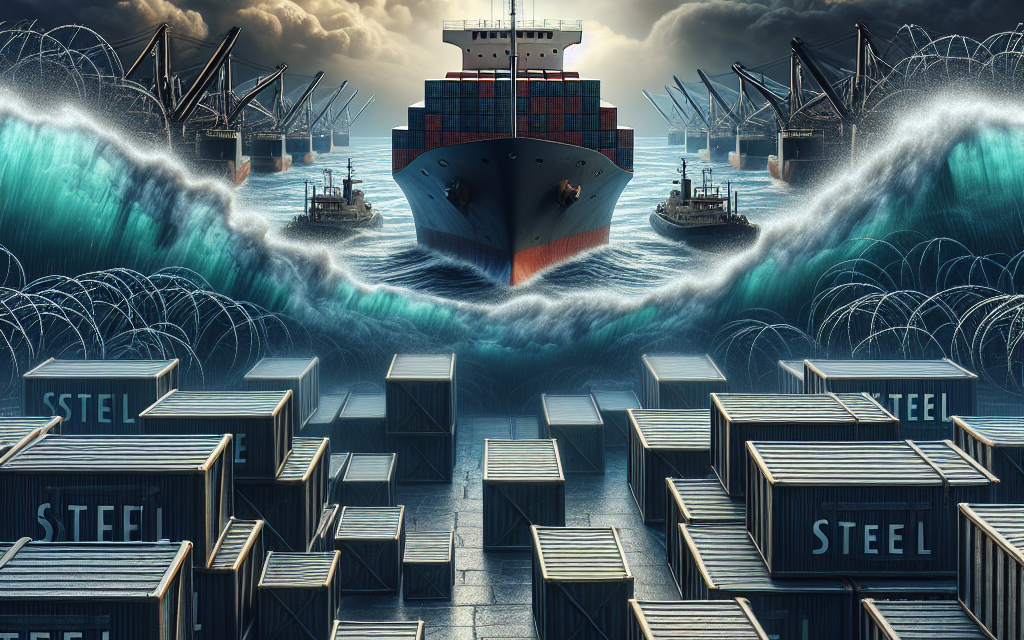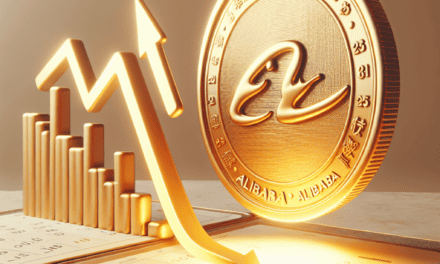“中国钢铁出口激增,挑战迫在眉睫”
Introduction
中国钢铁出口激增面临迫在眉睫的挑战
近年来,中国钢铁出口量显著增加,成为全球市场的重要供应者。然而,这一增长势头正面临多重挑战。国际市场需求波动、贸易保护主义抬头以及环保政策趋严等因素,正在对中国钢铁出口构成压力。此外,全球经济不确定性增加,也使得中国钢铁企业在国际市场上的竞争力受到考验。面对这些挑战,中国钢铁行业需要调整战略,以维持其在全球市场的地位。
Impact Of Global Trade Policies On Chinese Steel Exports
The recent surge in Chinese steel exports has captured the attention of global markets, as China continues to assert its dominance in the steel industry. However, this growth is not without its challenges, particularly in the face of evolving global trade policies. As the world’s largest steel producer, China’s export strategies significantly impact international trade dynamics, prompting various countries to reassess their trade policies to protect domestic industries. Consequently, the interplay between China’s export ambitions and global trade regulations presents a complex landscape that could reshape the future of the steel market.
To begin with, China’s steel industry has experienced remarkable growth over the past few decades, driven by robust domestic demand and substantial investments in production capacity. This expansion has enabled China to produce steel at a scale and cost that few countries can match, making it a formidable player in the global market. However, as domestic demand has plateaued, Chinese producers have increasingly turned to international markets to offload excess capacity. This shift has resulted in a significant increase in steel exports, which has, in turn, led to concerns about market saturation and unfair competition.
In response to the influx of Chinese steel, several countries have implemented protective measures to shield their domestic industries from what they perceive as unfair trade practices. For instance, the United States and the European Union have imposed anti-dumping duties and tariffs on Chinese steel imports, arguing that China’s state-subsidized production leads to artificially low prices that undermine local manufacturers. These measures aim to level the playing field and ensure that domestic producers can compete fairly in their home markets.
Moreover, the global trade environment is becoming increasingly complex, with geopolitical tensions and economic uncertainties influencing trade policies. The ongoing trade disputes between major economies, such as the United States and China, have further complicated the situation. These tensions have led to a series of tit-for-tat tariffs and trade barriers, which have disrupted supply chains and created an unpredictable trading environment. As a result, Chinese steel exporters must navigate a labyrinth of trade regulations and tariffs, which can hinder their ability to access key markets.
Additionally, environmental concerns are playing an increasingly important role in shaping trade policies. As countries strive to meet their climate commitments, there is growing pressure to reduce carbon emissions associated with steel production. This has led to the introduction of carbon border adjustment mechanisms, which impose tariffs on imports based on their carbon footprint. For China, which relies heavily on coal for steel production, these measures could pose a significant challenge, as they may increase the cost of exporting steel to regions with stringent environmental standards.
In light of these challenges, Chinese steel exporters are exploring strategies to adapt to the changing trade landscape. Diversifying export markets, investing in green technologies, and enhancing product quality are some of the approaches being considered to maintain competitiveness. Furthermore, diplomatic efforts to negotiate trade agreements and resolve disputes are crucial in ensuring continued access to international markets.
In conclusion, while the surge in Chinese steel exports underscores the country’s prowess in the global steel industry, it also highlights the imminent challenges posed by evolving global trade policies. As countries implement measures to protect their domestic industries and address environmental concerns, Chinese exporters must navigate a complex and dynamic trade environment. The outcome of these efforts will not only determine the future of China’s steel exports but also influence the broader dynamics of global trade.
Environmental Regulations And Their Effect On Steel Production
The recent surge in Chinese steel exports has captured global attention, as the nation continues to dominate the international steel market. However, this growth is not without its challenges, particularly in the realm of environmental regulations. As China seeks to balance its economic ambitions with environmental responsibilities, the steel industry finds itself at a critical juncture. The interplay between stringent environmental policies and steel production is poised to shape the future of this vital sector.
To begin with, China’s steel industry has long been a cornerstone of its economic development, contributing significantly to the country’s GDP and employment. However, the environmental impact of steel production cannot be overlooked. The process is energy-intensive and a major source of carbon emissions, which has led to increasing scrutiny from both domestic and international stakeholders. In response, the Chinese government has implemented a series of environmental regulations aimed at reducing pollution and promoting sustainable practices within the industry.
One of the most significant measures is the introduction of stricter emission standards for steel plants. These regulations require companies to invest in cleaner technologies and adopt more efficient production methods. While these changes are essential for reducing the industry’s carbon footprint, they also present substantial challenges for steel producers. The cost of compliance can be prohibitive, particularly for smaller firms that lack the financial resources to upgrade their facilities. Consequently, some companies may face the difficult decision of either merging with larger entities or exiting the market altogether.
Moreover, the Chinese government has also introduced policies to cap steel production in an effort to curb overcapacity and reduce environmental degradation. This move is intended to encourage more sustainable growth within the industry. However, it also poses a dilemma for steel producers who are eager to capitalize on the current demand for steel exports. Balancing production limits with market opportunities requires strategic planning and innovation, as companies must find ways to optimize their operations while adhering to regulatory constraints.
In addition to domestic policies, international pressure is mounting for China to take a more active role in addressing climate change. As a signatory to the Paris Agreement, China has committed to reducing its carbon emissions and transitioning to a low-carbon economy. This global commitment further underscores the need for the steel industry to align with environmental objectives. Failure to do so could result in trade tensions and potential tariffs from countries that are increasingly prioritizing sustainability in their trade policies.
Despite these challenges, there are opportunities for the Chinese steel industry to thrive in this new regulatory landscape. By investing in research and development, companies can explore innovative technologies such as hydrogen-based steelmaking and carbon capture and storage. These advancements not only have the potential to reduce emissions but also position Chinese steel producers as leaders in sustainable manufacturing. Furthermore, collaboration with international partners can facilitate the exchange of knowledge and best practices, fostering a more resilient and environmentally conscious industry.
In conclusion, the surge in Chinese steel exports is set against a backdrop of evolving environmental regulations that present both challenges and opportunities. As the industry navigates this complex terrain, the ability to adapt and innovate will be crucial. By embracing sustainable practices and aligning with global environmental goals, China’s steel industry can continue to play a pivotal role in the global market while contributing to a more sustainable future.
The Role Of Currency Fluctuations In Steel Export Competitiveness
The recent surge in Chinese steel exports has been a topic of considerable interest within the global economic landscape, as it underscores the intricate dynamics of international trade and the pivotal role of currency fluctuations in shaping export competitiveness. As the world’s largest steel producer, China has consistently leveraged its manufacturing prowess to dominate the global steel market. However, the current surge in exports is not merely a reflection of production capacity but is intricately linked to the fluctuations in currency values, which have a profound impact on the competitiveness of Chinese steel in international markets.
To understand the relationship between currency fluctuations and steel export competitiveness, it is essential to consider the broader economic context. The value of the Chinese yuan relative to other major currencies plays a crucial role in determining the price competitiveness of Chinese steel. A weaker yuan makes Chinese exports cheaper and more attractive to foreign buyers, thereby boosting demand. Conversely, a stronger yuan can render Chinese steel more expensive on the global market, potentially dampening export volumes. This delicate balance highlights the importance of currency management in maintaining export competitiveness.
In recent months, the yuan has experienced significant fluctuations, influenced by a myriad of factors including trade tensions, monetary policy adjustments, and shifts in global economic conditions. These fluctuations have, in turn, affected the pricing strategies of Chinese steel exporters. For instance, during periods of yuan depreciation, Chinese steel producers have been able to offer more competitive prices, thereby increasing their market share in key regions such as Southeast Asia and Europe. This strategic pricing advantage has been instrumental in driving the recent surge in exports.
However, the reliance on currency fluctuations as a tool for enhancing export competitiveness is fraught with challenges. For one, currency markets are inherently volatile and subject to sudden shifts that can disrupt carefully laid plans. Moreover, the use of currency devaluation as a competitive strategy can invite retaliatory measures from trading partners, leading to potential trade disputes and tariffs that could negate any short-term gains. Additionally, over-reliance on currency depreciation can mask underlying inefficiencies within the domestic steel industry, such as overcapacity and environmental concerns, which require structural reforms rather than temporary fixes.
Furthermore, the global steel market is characterized by intense competition, with other major producers such as India, Japan, and South Korea also vying for market share. These countries are equally adept at leveraging currency fluctuations to their advantage, creating a dynamic and often unpredictable competitive landscape. As such, Chinese steel exporters must navigate not only the complexities of currency markets but also the strategic maneuvers of their international counterparts.
In conclusion, while currency fluctuations undeniably play a significant role in shaping the competitiveness of Chinese steel exports, they are but one piece of a larger puzzle. To sustain their position in the global market, Chinese steel producers must adopt a multifaceted approach that includes enhancing production efficiency, investing in technological innovation, and addressing environmental concerns. By doing so, they can mitigate the risks associated with currency volatility and ensure long-term competitiveness in an ever-evolving global economic environment. As the world continues to grapple with economic uncertainties, the ability to adapt and innovate will be key to maintaining a competitive edge in the steel industry.
Technological Advancements In Steel Manufacturing

The global steel industry has long been a cornerstone of industrial development, and recent technological advancements have significantly reshaped its landscape. In particular, China’s steel manufacturing sector has experienced a surge in exports, driven by innovations that have enhanced production efficiency and product quality. However, this surge faces imminent challenges that could impact its sustainability and growth.
To begin with, the integration of advanced technologies such as automation, artificial intelligence, and data analytics has revolutionized steel manufacturing processes. Chinese steel producers have been at the forefront of adopting these technologies, enabling them to optimize production lines, reduce waste, and improve the precision of steel products. Automation, for instance, has minimized human error and increased the speed of production, while AI-driven analytics have provided insights into operational efficiencies and market trends. Consequently, these advancements have allowed Chinese steel manufacturers to produce high-quality steel at competitive prices, thereby boosting their export capabilities.
Moreover, the development of new steel alloys and the refinement of existing ones have further strengthened China’s position in the global market. Through research and development, Chinese companies have been able to create steel products that meet the diverse needs of various industries, from construction to automotive manufacturing. These innovations have not only expanded the range of applications for Chinese steel but have also enhanced its appeal to international buyers seeking reliable and versatile materials.
Despite these technological strides, the surge in Chinese steel exports is not without its challenges. One significant issue is the growing concern over environmental sustainability. The steel industry is traditionally energy-intensive and a major contributor to carbon emissions. As global awareness of climate change intensifies, there is increasing pressure on steel manufacturers to adopt greener practices. In response, Chinese companies are investing in technologies that reduce emissions and improve energy efficiency, such as electric arc furnaces and carbon capture systems. However, the transition to sustainable production methods is complex and costly, posing a challenge to maintaining competitive pricing.
In addition to environmental concerns, geopolitical tensions and trade policies present further obstacles. The global steel market is highly sensitive to international relations, and trade disputes can lead to tariffs and restrictions that hinder export growth. For instance, recent trade tensions between China and other major economies have resulted in increased scrutiny and regulatory barriers for Chinese steel exports. Navigating these geopolitical landscapes requires strategic diplomacy and adaptability from Chinese manufacturers to ensure continued access to key markets.
Furthermore, the rapid pace of technological change itself poses a challenge. As new technologies emerge, companies must continuously invest in research and development to stay ahead of the competition. This requires not only financial resources but also a skilled workforce capable of implementing and managing these innovations. The demand for skilled labor in the steel industry is growing, and Chinese manufacturers must address this need to sustain their technological edge.
In conclusion, while technological advancements have propelled the surge in Chinese steel exports, the industry faces a complex array of challenges that could impact its future trajectory. Environmental sustainability, geopolitical dynamics, and the need for ongoing innovation are critical factors that Chinese steel manufacturers must navigate. By addressing these challenges, they can continue to leverage technological advancements to maintain their competitive position in the global market.
Domestic Demand Versus Export Priorities In China
In recent years, China’s steel industry has experienced a significant surge in exports, driven by a combination of domestic overproduction and competitive pricing on the global market. This trend, however, is now facing imminent challenges as the country grapples with balancing domestic demand and export priorities. The Chinese government has been actively promoting infrastructure development and urbanization, which has led to an increased demand for steel within its borders. Consequently, this domestic demand is beginning to compete with the export market, creating a complex scenario for policymakers and industry leaders.
To understand the dynamics at play, it is essential to consider the factors contributing to the rise in Chinese steel exports. China’s steel production capacity has expanded rapidly over the past decade, resulting in a surplus that has been channeled into international markets. This surplus, coupled with China’s ability to produce steel at lower costs than many of its competitors, has allowed the country to capture a significant share of the global steel market. However, as domestic infrastructure projects gain momentum, the need to allocate more steel for internal use becomes increasingly pressing.
The Chinese government is acutely aware of the need to strike a balance between supporting domestic growth and maintaining its position as a leading steel exporter. On one hand, prioritizing domestic demand could bolster the country’s economic development and help achieve long-term strategic goals. On the other hand, reducing exports could lead to a loss of market share and weaken China’s influence in the global steel industry. This delicate balancing act is further complicated by international trade tensions and the imposition of tariffs on Chinese steel by several countries, which have already begun to impact export volumes.
In response to these challenges, China is exploring various strategies to optimize its steel production and distribution. One approach involves investing in advanced technologies and processes to enhance production efficiency and reduce costs. By doing so, China aims to maintain its competitive edge in both domestic and international markets. Additionally, the government is encouraging steel producers to diversify their product offerings and focus on high-value-added products that can command premium prices. This shift could help mitigate the impact of reduced export volumes by increasing revenue from domestic sales.
Moreover, China is also considering policy measures to regulate steel production and ensure that domestic needs are met without compromising export capabilities. These measures may include adjusting export tariffs, implementing production quotas, and providing incentives for companies that prioritize domestic supply. Such policies could help create a more sustainable balance between domestic demand and export priorities, although they may also face resistance from industry stakeholders who are concerned about potential disruptions to their operations.
In conclusion, the surge in Chinese steel exports is encountering significant challenges as the country seeks to reconcile domestic demand with its export ambitions. The outcome of this balancing act will have far-reaching implications for China’s steel industry and its role in the global market. As China navigates these complexities, it will be crucial for policymakers and industry leaders to adopt a strategic approach that considers both short-term needs and long-term objectives. By doing so, China can continue to play a pivotal role in the global steel industry while supporting its domestic economic growth.
Trade Tensions And Their Influence On Steel Export Markets
The recent surge in Chinese steel exports has become a focal point in global trade discussions, as it presents both opportunities and challenges for international markets. This increase in exports is largely driven by China’s robust production capabilities and competitive pricing strategies, which have allowed it to capture a significant share of the global steel market. However, this expansion is not without its complications, as it coincides with rising trade tensions and protectionist measures from various countries. These factors are poised to influence the dynamics of steel export markets in the near future.
To begin with, China’s steel industry has long been a powerhouse, benefiting from economies of scale and substantial government support. This has enabled Chinese steel producers to offer lower prices compared to their international counterparts, thereby increasing their attractiveness to foreign buyers. As a result, Chinese steel exports have seen a marked increase, particularly to regions where infrastructure development is a priority. However, this competitive edge has also led to growing concerns among other steel-producing nations, who view the influx of Chinese steel as a threat to their domestic industries.
In response to these concerns, several countries have implemented protective measures aimed at curbing the import of Chinese steel. For instance, the United States and the European Union have imposed tariffs and anti-dumping duties on Chinese steel products, arguing that these measures are necessary to protect their domestic industries from unfair competition. These actions have, in turn, led to heightened trade tensions between China and its trading partners, complicating the landscape for steel exports.
Moreover, the global steel market is also being influenced by broader geopolitical factors, such as the ongoing trade disputes between major economies. These disputes have created an environment of uncertainty, which can affect investment decisions and disrupt supply chains. For example, the trade war between the United States and China has had ripple effects across various sectors, including steel, as both countries have imposed tariffs on each other’s goods. This has not only affected bilateral trade but has also prompted other countries to reassess their trade policies in light of these developments.
In addition to trade tensions, environmental concerns are increasingly shaping the steel export market. As countries strive to meet their climate commitments, there is a growing emphasis on reducing carbon emissions from industrial processes, including steel production. This has led to calls for more sustainable practices and the adoption of green technologies in the steel industry. Consequently, Chinese steel producers may face pressure to align with these global environmental standards, which could impact their production costs and export strategies.
Despite these challenges, there are opportunities for Chinese steel exporters to adapt and thrive in this evolving landscape. By investing in innovative technologies and enhancing the quality of their products, Chinese steel producers can differentiate themselves in the market and meet the changing demands of international buyers. Furthermore, engaging in dialogue with trading partners to address concerns and foster cooperation could help mitigate some of the trade tensions currently affecting the industry.
In conclusion, while the surge in Chinese steel exports presents significant opportunities for growth, it also faces imminent challenges stemming from trade tensions and environmental considerations. As the global steel market continues to evolve, it will be crucial for Chinese exporters to navigate these complexities and adapt to the shifting landscape in order to maintain their competitive edge.
Strategies For Chinese Steel Producers To Overcome Export Challenges
The recent surge in Chinese steel exports has been a significant development in the global steel market, driven by a combination of domestic overproduction and competitive pricing strategies. However, this increase in exports is not without its challenges. Chinese steel producers must navigate a complex landscape of international trade regulations, fluctuating demand, and environmental concerns to maintain their competitive edge. To address these challenges, strategic adjustments are essential.
Firstly, Chinese steel producers must enhance their focus on product quality and innovation. As global markets become increasingly competitive, the demand for high-quality steel products is on the rise. By investing in advanced manufacturing technologies and research and development, Chinese producers can differentiate their products and meet the stringent quality standards required by international buyers. This approach not only helps in capturing a larger market share but also in building long-term relationships with global clients.
In addition to quality improvements, diversification of export markets is crucial. Relying heavily on a few key markets can expose producers to significant risks, especially in the face of geopolitical tensions and trade disputes. By expanding their reach to emerging markets in Africa, Southeast Asia, and Latin America, Chinese steel producers can mitigate these risks and tap into new growth opportunities. This diversification strategy requires a deep understanding of local market dynamics and the establishment of robust distribution networks.
Moreover, compliance with international trade regulations is imperative for sustaining export growth. The global steel industry is subject to a myriad of trade policies, including tariffs, quotas, and anti-dumping measures. Chinese producers must stay informed about these regulations and adapt their strategies accordingly. Engaging with international trade bodies and fostering diplomatic relations can also help in addressing trade barriers and ensuring smoother market access.
Environmental sustainability is another critical area that Chinese steel producers must address. As global awareness of climate change and environmental degradation increases, there is mounting pressure on industries to adopt sustainable practices. By investing in cleaner production technologies and reducing carbon emissions, Chinese steel producers can not only comply with international environmental standards but also enhance their reputation as responsible global players. This shift towards sustainability can also open up new markets that prioritize eco-friendly products.
Furthermore, strategic partnerships and collaborations can play a pivotal role in overcoming export challenges. By forming alliances with foreign companies, Chinese steel producers can gain valuable insights into local markets, share technological expertise, and co-develop innovative products. These partnerships can also facilitate access to new distribution channels and enhance the overall competitiveness of Chinese steel in the global market.
Finally, effective risk management strategies are essential for navigating the uncertainties of the global steel market. This involves not only financial risk management, such as hedging against currency fluctuations and commodity price volatility, but also operational risk management, including supply chain optimization and contingency planning. By adopting a proactive approach to risk management, Chinese steel producers can better withstand market disruptions and maintain a steady export flow.
In conclusion, while the surge in Chinese steel exports presents significant opportunities, it also poses a range of challenges that require strategic responses. By focusing on quality enhancement, market diversification, regulatory compliance, environmental sustainability, strategic partnerships, and risk management, Chinese steel producers can effectively navigate these challenges and secure their position in the global steel market. Through these concerted efforts, they can not only sustain their export growth but also contribute positively to the global steel industry.
Q&A
1. **Question:** What factors have contributed to the recent surge in Chinese steel exports?
– **Answer:** The surge in Chinese steel exports has been driven by increased domestic production, competitive pricing, and strong global demand.
2. **Question:** How has the global market reacted to the increase in Chinese steel exports?
– **Answer:** The global market has experienced increased competition, leading to concerns about market saturation and potential trade tensions.
3. **Question:** What challenges are Chinese steel exporters currently facing?
– **Answer:** Chinese steel exporters are facing challenges such as potential trade barriers, anti-dumping measures, and fluctuating global demand.
4. **Question:** How might international trade policies impact Chinese steel exports?
– **Answer:** International trade policies, including tariffs and quotas, could restrict market access and reduce export volumes for Chinese steel.
5. **Question:** What role does domestic policy play in the Chinese steel export market?
– **Answer:** Domestic policy, including government regulations and environmental standards, can influence production levels and export capabilities.
6. **Question:** How are environmental concerns affecting the Chinese steel industry?
– **Answer:** Environmental concerns are leading to stricter regulations and potential production cuts, which could impact export levels.
7. **Question:** What strategies might Chinese steel producers adopt to address these challenges?
– **Answer:** Chinese steel producers might focus on improving product quality, diversifying markets, and investing in sustainable production technologies.
Conclusion
The surge in Chinese steel exports is encountering imminent challenges due to several factors. Firstly, global demand fluctuations, driven by economic uncertainties and geopolitical tensions, are affecting export volumes. Secondly, increasing trade protectionism and tariffs imposed by various countries are creating barriers for Chinese steel in international markets. Additionally, China’s domestic policies aimed at reducing carbon emissions and transitioning to greener production methods are likely to impact steel output and export capabilities. These challenges suggest that while Chinese steel exports have been robust, sustaining this growth will require strategic adjustments to navigate the evolving global trade landscape.





